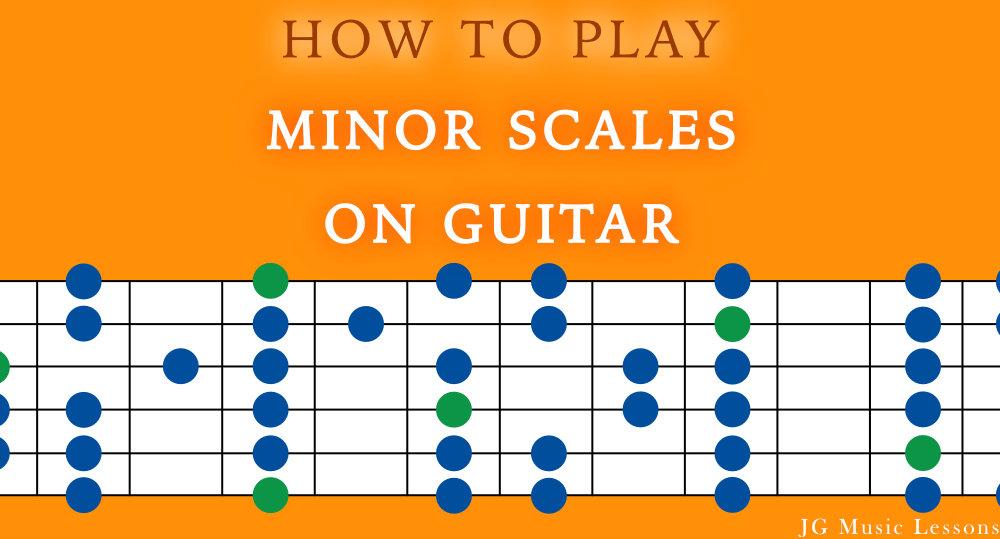One of the most fundamental scales to learn on guitar is the minor scale. Regardless of what genre you’re playing, you need to know the minor scale when playing melodies or improvising in minor keys.
Although the minor scale can be played in one position of the guitar, the same set of notes can be played on different areas of the fretboard. That being said, this lesson covers the 5 minor scale shapes you need to know in order to play the scale throughout the fretboard.
This will help you to connect the notes on the fretboard and give you the freedom and flexiblity to explore different ideas without limiting yourself to one position.
Grab your guitar and let’s get started!
Minor scale formula
The minor scale is a set of 7 notes which includes the scale degrees 1, 2, b3 (flat 3), 4, 5, b6, and b7. For example, the E minor scale has the notes E, F#, G, A, B, C, and D. This would be the natural minor scale, not to be confused with other types minor scales which we’ll go over in the next section.
There is also a whole and half step formula we can use to find the distance between the notes which make up a minor scale. The minor scale formula is whole, half, whole step, and then whole, half, whole, whole step which you can see in the chart below.

Quick tip: If you already know the Major scale, you simply start on the 6th degree to play the relative minor scale. For example, the notes of a G Major scale are the same as an E minor scale since they share the same key signature.
As a side note, the natural minor scale can also be referred to as the Aeolian scale, which is 6th mode of the Major scale.
Different types of minor scales
It’s important to note that there are different types of minor scales with slight note variations. Here is a brief overview of the scale degrees included in other closely related scales.
- The melodic minor scale has the scale degrees 1, 2, b3, 4, 5, 6, and 7. For example, the E melodic minor scale has the notes E, F#, G, A, B, C#, and D#.
- The harmonic minor scale has the scale degrees 1, 2, b3, 4, 5, b6, and 7. For example, the E harmonic minor scale has the notes E, F#, G, A, B, C, and D#.
- The Dorian scale has the scale degrees 1, 2, b3, 4, 5, 6, and b7. For example, the E Dorian scale has the notes E, F#, G, A, B, C#, and D.
- The Phrygian scale has the scale degrees 1, b2, b3, 4, 5, b6, and b7. For example, the E Phrygian scale has the notes E, F, G, A, B, C, and D.
However, this lesson will focus on the natural minor scale and we’ll simply refer to it as the minor scale.
Minor scale examples
Now let’s apply this minor scale formula to different keys. Each scale below will cover two octaves on the guitar in standard notation with tabs and audio examples included.
The small numbers on top of the notes represent the suggested fingerings for your fretting hand.
Even though these minor examples are written 4/4 time, you can apply the notes to any time signature.
C minor scale
The notes of the C natural minor scale are C, D, Eb, F, G, Ab, and Bb.

D minor scale
The notes of the D natural minor scale are D, E, F, G, A, Bb, and C.

You can learn the 5 D minor scale shapes here.
E minor scale
The notes of the E natural minor scale are E, F#, G, A, B, C, and D.

G minor scale
The notes of the G natural minor scale are G, A, Bb, C, D, Eb, and F.

F minor scale
The notes of the F natural minor scale are F, G, Ab, Bb, C, Db, and Eb.

You can learn the 5 F minor scale shapes here.
B minor scale
The notes of the B natural minor scale are B, C#, D, E, F#, G, and A.

You can learn the 5 B minor scale shapes here.
Minor scales chart
Here is a chart of the notes included in different minor scales.
| Natural minor scale | 1 | 2 | b3 | 4 | 5 | b6 | b7 |
|---|---|---|---|---|---|---|---|
| C minor scale | C | D | Eb | F | G | Ab | Bb |
| D minor scale | D | E | F | G | A | Bb | C |
| E minor scale | E | F# | G | A | B | C | D |
| F minor scale | F | G | Ab | Bb | C | Db | Eb |
| G minor scale | G | A | Bb | C | D | Eb | F |
| A minor scale | A | B | C | D | E | F | G |
| B minor scale | B | C# | D | E | F# | G | A |
| Db minor scale | Db | Eb | E | Gb | Ab | A | B |
| Eb minor scale | Eb | F | Gb | Ab | Bb | B | Db |
| Gb minor scale | Gb | Ab | A | B | Db | D | E |
| Ab minor scale | Ab | Bb | B | Db | Eb | E | Gb |
| Bb minor scale | Bb | C | Db | Eb | F | Gb | Ab |
Now that you know the theory behind what makes up a minor scale, let’s start learning the five shapes you can use for playing the minor scale on guitar.
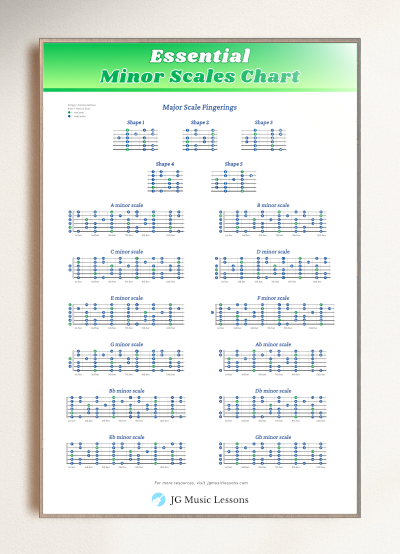
5 Minor scale shapes on guitar
We can break down the minor scale into five different sections of the guitar fretboard. You can play these shapes starting on any root note.
Even though these scale shapes include the same notes as the 5 Major scale shapes, it helps to visualize where the root notes of the minor scale are within each shape.
How to read the scale charts
For the charts below:
- The lowest horizontal line represents the thickest string (Low E). The top horizontal line represents the thinnest string (high E).
- The green circles represent the root note of the minor scale and the blue notes are every scale note in between.
- The numbers inside the circles represent the suggested fingering to use on your fretting hand.
If needed, check out how to read guitar notation symbols.
Minor scale shape 1
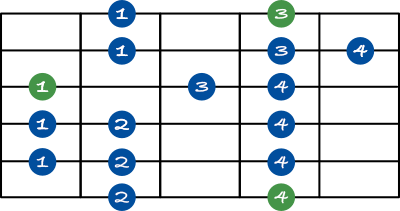
Minor scale shape 2
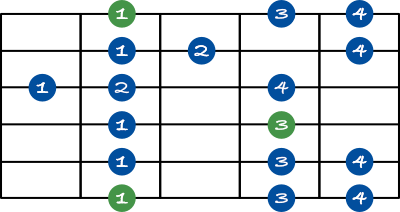
Minor scale shape 3
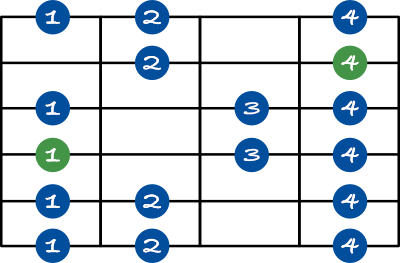
Minor scale shape 4
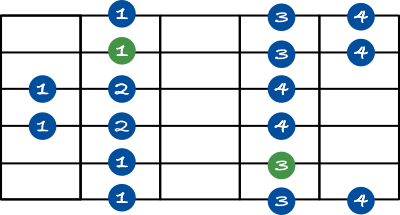
Minor scale shape 5
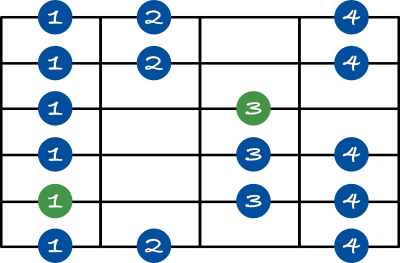
One thing to note about using these shapes is that whenever you have scales that use notes with open strings, you have to rearrange your fingers to play the shape. For example, if the shape uses the fingering 1, 3, and 4 on one string, you can play (open string), 1 and 3 instead.
Although you will need to change some shapes if you include open strings, once you move over to the next shape where you’re fretting all the notes, you will get back to the original shapes we covered.
3 tips for memorizing the minor scale shapes
Here are 3 quick tips to help you memorize the minor scale shapes.
1. Master one shape at a time
The way I recommend learning and memorizing any scale is to start with one shape that feels most comfortable for you. Try to really get the shape under your fingers to the point where you don’t have to look at the chart. Use the first shape you master as a guide to learn the other scale shapes around it.
2. Look for repeating fingering patterns
You want to look for patterns such as what strings repeat the same fingering within a shape.
Quick tip: The notes on the first and sixth string will always be the same.
For example, in shape 3 we see that the 1st, 5th, and 6th string follow a 1, 2, and 4 finger pattern. The 3rd and 4th string follow a 1, 3, and 4 finger pattern. The 2nd string only has two notes.
Knowing where fingering patterns repeat will help you build a mental map of a scale shape.
3. Learn to connect the scale shapes
After getting one of the shapes down really well, either learn the shape that comes before or after it to see how the scale connects on the fretboard. Again, try to master one shape at a time and make sure you can play it without looking at the chart.
This will make the process more approachable by breaking it down into smaller sections before moving on to the next shape.
What to do after learning the minor scales shapes
After getting comfortable with the minor scale shapes, try creating melodies or musical phrases with the notes in the scale. We don’t want to just play a scale mechanically but be able to make music with it as soon as possible.
A way to do this is by first humming or singing a short melody line and then try figuring out what those notes are on your instrument. This is the first step to being able to improvise on your instrument. The goal is to try playing what you want to hear. To learn more about this you can also check out this post on how to develop ear training.
You can also take a short melody or phrase and try shifting it to another key. You know you really have a scale down when you can play it in any given key and in any part of the fretboard.
I also recommend challenging yourself to play a scale with good timing by using a metronome (here’s a free metronome on this site). Or you can play the scale in different patterns and sequences which I cover in this lesson on how to practice scales.
Another fun challenge is to try playing a scale horizontally, meaning on one string. Even though you wouldn’t naturally play it this way, this is to check whether you know all the notes that are included in a scale you’re working on. Just go through one string at a time and start playing the notes consecutively.
For example, to play the E minor scale, you would play these notes on the 6th string:

Relative Major scales
Did you know that every minor scale has a related Major scale? If you play a minor scale by starting and ending on the 3rd degree, you’re actually play the related Major scale. For example, the E minor scale and G Major scale have the same set of notes.
The whole and half step formula gets shifted and it looks like this for Major scales:

Check this lesson to learn the 5 Major scale shapes.
Wrapping up
Learning the 5 minor scale shapes will help you to gain a better understanding of the guitar as you learn to play the same set of notes throughout the fretboard. It’s easy to get used to only playing in one area of the guitar but learning the shapes will help to approach the scale in a new way.
The goal is to use these shapes to make music and be able to play single note phrases or melodies in a variety of ways. The scale shapes can help you create new ideas and allow you to play more comfortably when changing your range of notes or when playing in different keys.
Once you learn the minor scale, I also recommend checking out how to play minor pentatonic scales on guitar.
As mentioned earlier, this natural minor scale is also called the Aeolian scale, which is the 6th mode of the Major scale. You can also see an overview of the Major scale modes and their related emotions here or learn the specific scales below:
📘 Get the free guitar practice guide here!
Best,
JG Music Lessons
📙 Kickstart your guitar playing with our step by step guide: Guitar Essentials.
🎸 Looking for a travel or half-sized guitar? See this one.
🛠 See our other music recommendations.
🤝 Support the site to help us to create better content for you!
Level up with the FREE guitar practice guide and effectively improve your playing! 🎸
Get it sent to your email!

